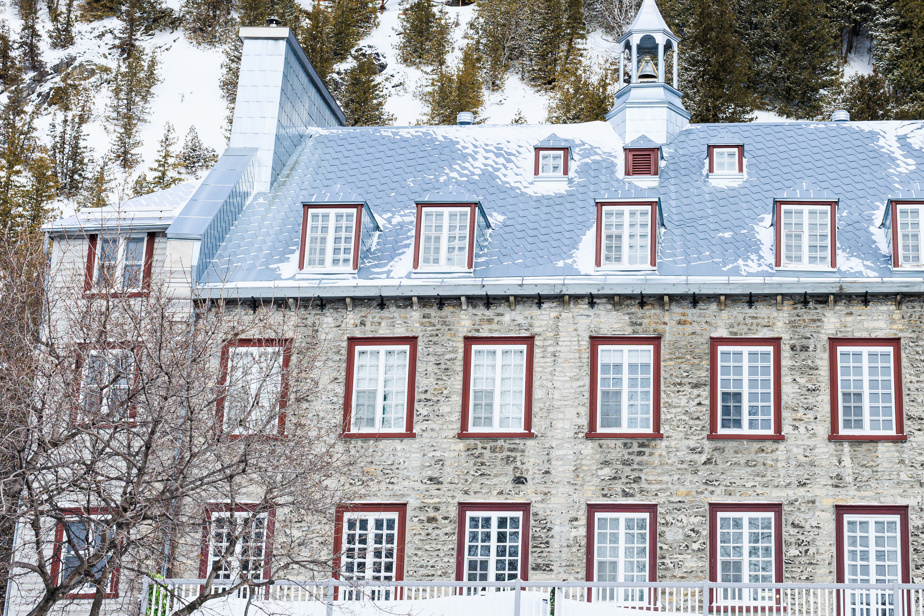At the foot of the Plains of Abraham, on the banks of the St. Lawrence River and a stone’s throw from Old Quebec, these are the assets that first seduced owner Diane Beaulieu. But once inside, she fell in love with this old school, transformed into a church before being converted into a residential building.
The Quebecer has been established in Paris for a long time. She was visiting her ailing father in 2010 when she saw the Champlain Boulevard condo for sale in a real estate flyer handed out at the hospital.
“I imagined myself coming back to live full-time in Quebec when I retire,” says Ms. Beaulieu, contacted in Paris. I would sit at the end of the table to write while watching the boats on the river. »
In the living room, the view is indeed inspiring. The condo is located on Boulevard Champlain, in the neighborhood known as Cap-Blanc. At this location, about a kilometer from Petit Champlain, only the road and the bike path separate the building from the river.
Four stories high, the stone building is impressive and beautifully maintained. It is also listed in the register of built heritage of the City of Quebec. It was built in 1841 at the request of the Archdiocese of Quebec. It was the first school in Cap-Blanc. Then, a few years later, a chapel was built inside. The building was then handed over to the Irish Catholic community who used it as a place of worship for almost a century.
The building was converted into a condo 40 years ago, and eight owners carefully maintain it. Diane Beaulieu’s accommodation is spread over two floors. The living room and the kitchen are on the first floor. The bathroom and the two bedrooms are on the ground floor.
One aspect, however, sets this unit apart from others: it is located in the building’s former chapel.
No religious sign has survived the building’s change of vocation, but subtle details still bear witness to its history.
“The rounded door is the entrance to the chapel,” explains Ms. Beaulieu fondly. It is the only unit to have this type of door. The ramp leading to the basement is also typical of churches. »
The untrained eye of the visitor does not understand either why a step raises the floor of the kitchen from that of the dining room and the living room.
Mrs. Beaulieu knows the reason: “It was the altar of the church,” she said. It continues in the neighbor’s condo. »
Since its construction in the 19th century, the stone building has been renovated several times. Large wooden galleries have been installed on the facade on the river side. An annex was erected on the west side to house an emergency exit. New shutters were installed and painted red.
Ms. Beaulieu admits for her part that she has not renovated her apartment very much. She redid the bathroom which is located on the ground floor, but she admits that the kitchen could be updated.
“I never came back to Quebec long enough to think about the work and I never had enough time to do it,” she says.
However, the possibilities are enormous.
On the stone walls, details bear witness to previous changes in the layout of the premises. Among them, the hearth of an old hearth is still on the wall of the staircase. Nearby, another fireplace is still functional.
The wooden beams that support the floor are visible on the garden level as well as in the open area of the staircase. In the living room, they are covered by a magnificent wooden coffered ceiling.
On the floor, the wide pine planks are probably not original, but they preserve the historic character of the place. Ditto for the paned windows. In addition to being very beautiful, the latter are so thick that they dampen the noise of the street. So much so that there is a monastic silence in the condo.
At the entrance to the building, archival photos show that before the construction of Champlain Boulevard, the river bank was very close. The ships came to refuel and anchor at the foot of the building. This traffic required a large workforce in the district. The working-class character of the neighborhood can be seen in the architecture of several small and simple houses. These stand alongside magnificent stone houses, adorned with symbols of ships and clover carved in stone on the facades, which remind us that Cap-Blanc has long been the district of the Irish.
But the neighborhood is changing. Local shops are rare but, located at the foot of Cap-Diamant, the Cap-Blanc staircase leads straight to the Plains of Abraham.
“I went to see a concert on foot again last summer,” says Ms. Beaulieu. We’re there in a few minutes. »
The owner also remembers the fireworks she observes every summer on her balcony.
“We are in the heart of Old Quebec, while being far from the hubbub, she adds. It is a magical place. »
Retirement will ring soon for this doctor by profession, aged 71, who however no longer plans to live in Quebec. Her two daughters have settled in Montreal and she will soon have no family in the capital. She now dreams of someone else writing the story of her little chapel.
Asking price: $599,000 Year built: 1841 Rooms: 9 rooms, including 2 bedrooms, 1 bathroom, 1 powder room, 1 wood fireplace, 1 terrace, 1 exit to the garden and 1 outdoor parking space. Area: 1,465 sq. ft. Condominium fees: $620 per month Municipal assessment: $475,000 Building: $339,000 Land: $136,000 Property tax: $4,753 per year Brokers: Evelyn Péladeau and Bryan Péladeau-Lefebvre















